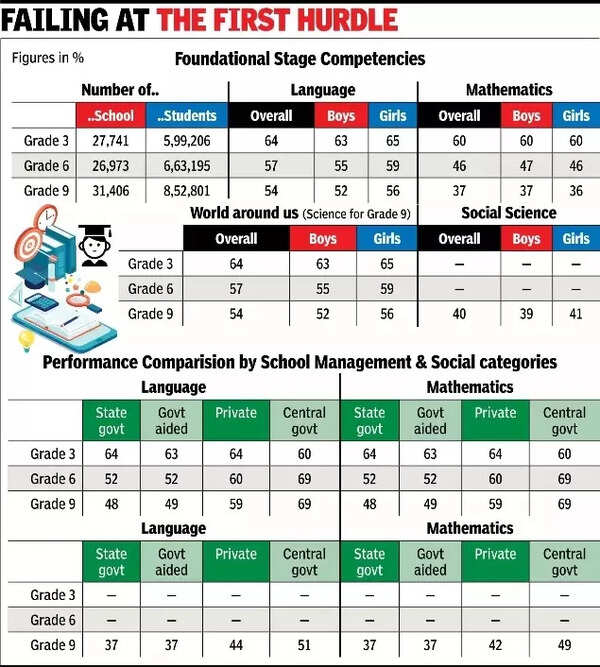
NEW DELHI: As many as 43% of India's schoolchildren in Class VI can't grasp main ideas in texts, and a staggering 63% of Class IX students fail to spot simple patterns in numbers or understand basic numerical sets like fractions and integers, the ministry of education's PARAKH Rashtriya Sarvekshan, formerly known as National Achievement Survey (NAS), has revealed.
In what further highlights the scale of learning gaps in the country's education system, 54% of Class VI students are unable to compare whole numbers or read large numbers.The PARAKH Rashtriya Sarvekshan, conducted in Dec last year, assessed 21,15,022 students from Grades III, VI and IX across 74,229 schools, both govt and private, in 781 districts spanning 36 states and union territories.For instance, students struggled with tasks like identifying multiples of 7, powers of 3, prime numbers, and applying percentage and fraction concepts to daily-life problems.
Science and social science learning was no better, with over 60% of Class IX students failing to meet minimum competency benchmarks. In science, students were unable to classify matter based on physical and chemical characteristics, describe changes in matter using the particulate nature of substances, or explain properties of a magnet.

Social science assessments asked students to collect and interpret data from maps, charts, and texts, and to explain natural phenomena like climate and soil formation, but most failed to meet the expected benchmarks.
For Class VI students, the findings were equally concerning. In language skills, 43% were unable to apply varied comprehension strategies such as inference, prediction, and visualisation, or understand main ideas and draw conclusions from the material read. But mathematics remained the biggest challenge, with 54% of students unable to represent numbers using place value, compare whole numbers, or apply the four basic operations to solve daily problems.At the foundational stage in Class III, only 55% of students could arrange numbers up to 99 in ascending or descending order, and just 58% could perform addition and subtraction of two-digit numbers. In mathematics, central govt schools recorded the lowest performance in this grade.
The study revealed that the rural-urban divide and gender gaps persist in critical areas. Central govt-run schools (Kendriya Vidyalayas) emerged as the best performers, yet even for them the data showed concerning trends. The survey also flagged wide inter-state variations. Among the top ten states, Punjab, Kerala, Himachal Pradesh, Odisha, and Rajasthan figured consistently for all three grades. Conversely, J&K and Meghalaya featured on the list of ten worst-performing states across the three grades, with states like West Bengal, Tamil Nadu, Uttarakhand and Jharkhand being among poor performers for two grades.

 5 hours ago
45
5 hours ago
45




























 English (US)
English (US)